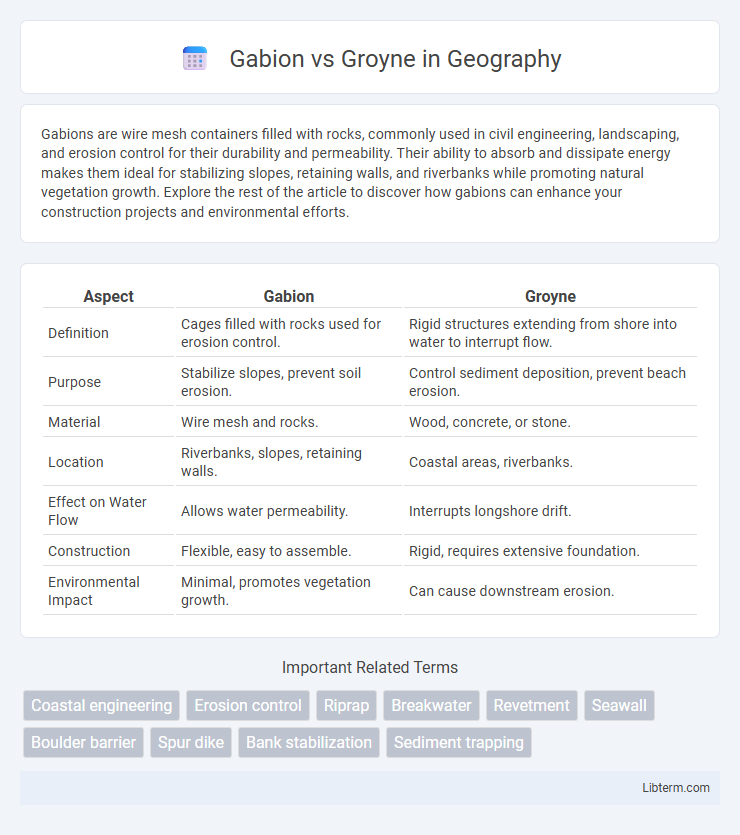Gabions are wire mesh containers filled with rocks, commonly used in civil engineering, landscaping, and erosion control for their durability and permeability. Their ability to absorb and dissipate energy makes them ideal for stabilizing slopes, retaining walls, and riverbanks while promoting natural vegetation growth. Explore the rest of the article to discover how gabions can enhance your construction projects and environmental efforts.
Table of Comparison
| Aspect | Gabion | Groyne |
|---|---|---|
| Definition | Cages filled with rocks used for erosion control. | Rigid structures extending from shore into water to interrupt flow. |
| Purpose | Stabilize slopes, prevent soil erosion. | Control sediment deposition, prevent beach erosion. |
| Material | Wire mesh and rocks. | Wood, concrete, or stone. |
| Location | Riverbanks, slopes, retaining walls. | Coastal areas, riverbanks. |
| Effect on Water Flow | Allows water permeability. | Interrupts longshore drift. |
| Construction | Flexible, easy to assemble. | Rigid, requires extensive foundation. |
| Environmental Impact | Minimal, promotes vegetation growth. | Can cause downstream erosion. |
Introduction to Coastal Protection Structures
Gabions and groynes serve as essential coastal protection structures designed to prevent erosion and manage sediment movement along shorelines. Gabions, composed of wire mesh cages filled with rocks, provide flexible and permeable barriers that dissipate wave energy and promote sediment accumulation. Groynes, typically built from wood, concrete, or rock, extend perpendicular to the coastline to trap sand transported by longshore drift, stabilizing beaches and reducing coastal retreat.
What is a Gabion?
A gabion is a wire mesh cage filled with rocks, concrete, or sand used in civil engineering, road building, and landscaping for erosion control and retaining walls. Its porous structure allows water to pass through while stabilizing soil and preventing washouts along shorelines or riverbanks. Gabions differ from groynes, which are rigid structures extending into water to interrupt flow and limit sediment movement.
What is a Groyne?
A groyne is a rigid hydraulic structure built perpendicular to the shoreline, designed to interrupt water flow and limit beach erosion by trapping sand and sediments. Typically constructed from wood, concrete, or rock, groynes help maintain beach stability by reducing the impact of longshore drift. Unlike gabions, which are wire cages filled with rocks used primarily for slope stabilization and retaining walls, groynes specifically serve to protect coastal areas by controlling sediment movement.
Key Differences Between Gabions and Groynes
Gabions are wire mesh containers filled with rocks or soil used primarily for erosion control and slope stabilization, whereas groynes are rigid structures, often made of wood, concrete, or stone, extending perpendicular to the shoreline to interrupt water flow and prevent sediment displacement. Gabions offer flexibility and permeability, allowing water to pass through and reducing hydraulic pressure, while groynes act as physical barriers that trap sand and promote beach accretion. The choice between gabions and groynes depends on site-specific factors such as wave energy, sediment transport, and environmental impact considerations.
Construction Materials and Methods
Gabion structures are constructed using wire mesh cages filled with rocks or stones, providing flexibility and permeability ideal for erosion control and shoreline protection. Groynes are built from rigid materials such as timber, concrete, or steel, extending perpendicular to the shore to interrupt water flow and sediment movement, often requiring extensive foundation work for stability. Both methods utilize durable, weather-resistant materials suited to their coastal or riverine environments, with gabions relying on modular assembly and groynes on heavy construction techniques.
Durability and Maintenance Compared
Gabions offer superior durability due to their galvanized steel mesh construction filled with heavy stones, resisting erosion and weathering effectively, while groynes, commonly made from wood or concrete, may suffer from decay or cracking over time. Maintenance for gabions typically involves less frequent repairs as their flexible structure adapts to ground movement, whereas groynes require regular inspection and reinforcement to prevent structural damage and sediment buildup. Both structures serve coastal protection, but gabions provide longer-lasting performance with lower maintenance demands in harsh environmental conditions.
Environmental Impact Assessment
Gabions, constructed from wire mesh filled with rocks, promote natural sediment deposition and enhance local biodiversity while minimizing shoreline erosion, making them favorable in Environmental Impact Assessments (EIA) for sustainable coastal management. Groynes, rigid structures extending perpendicular to shorelines, often cause sediment accumulation upstream but can increase erosion downstream, leading to potential habitat disruption and adverse impacts on coastal ecosystems flagged in EIA studies. Evaluating long-term ecological effects and sediment transport patterns is crucial in EIA to choose between gabions and groynes for mitigating shoreline erosion with minimal environmental damage.
Cost Analysis: Gabion vs Groyne
Gabion structures typically offer lower initial installation costs due to the use of readily available materials like wire mesh and rocks, making them cost-effective for small to medium-scale erosion control projects. Groynes, involving extensive construction with concrete or timber, require higher upfront investment but provide longer-term durability and reduced maintenance expenses over time. Evaluating cost-effectiveness depends on project scale, site conditions, and lifespan expectations, with gabions favoring budget constraints and groynes suited for permanent coastal defense.
Best Use Cases and Applications
Gabions are wire mesh containers filled with rocks, ideal for erosion control, slope stabilization, and retaining walls in both urban and rural settings due to their flexibility and permeability. Groynes are rigid coastal structures built perpendicular to shorelines primarily for preventing beach erosion by interrupting longshore drift and trapping sediment. Gabions perform best in riverbanks and hillside protection where water flow management is essential, whereas groynes are most effective along sandy coasts requiring shoreline stabilization and sediment accumulation.
Conclusion: Choosing the Right Solution
Gabions offer flexible, permeable, and eco-friendly erosion control ideal for sloped banks and areas requiring vegetation growth, while groynes provide rigid, structural protection by interrupting water flow, suitable for controlling sediment deposition along coastlines. Selecting the right solution depends on site-specific factors like hydrodynamics, sediment transport, environmental impact, and project durability requirements. Combining both techniques can be effective in complex coastal or riverine environments to optimize shoreline stabilization and habitat preservation.
Gabion Infographic

 libterm.com
libterm.com